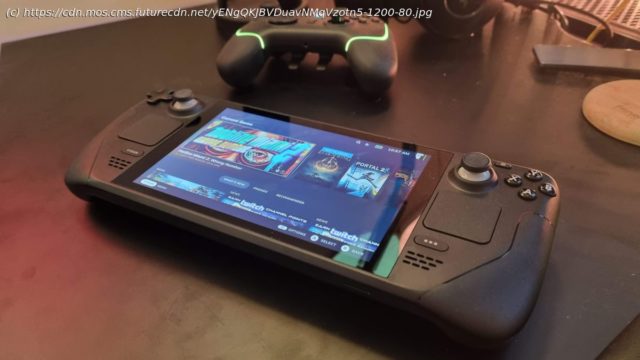Valve’s first handheld has great potential – but there’s still work to be done.
The Steam Deck is one of the most eagerly anticipated product launches in recent times, with Valve trying its hand at making a handheld console. It’s certainly an ambitious task, but one that Valve mostly pulls off. However, as much as you may think the Steam Deck is a Nintendo Switch rival, it’s actually more of an alternative to gaming laptops. This means if you’re a PC gamer with a large Steam library, and you’re used to the quirks and annoyances that come with playing PC games, then you’ll likely love the Steam Deck and overlook its rougher edges. However, if you’re a console player who’s used to more polished products that keep things as simple and straightforward as possible, you may be disappointed. Some of the rough edges of the Steam Deck are a part of its charm, however, and in some cases are due to the flexibility of the device, which traditional consoles just can’t offer. You can plug in pretty much any USB-C hub, hook up a monitor or TV and play games on the big screen. You can also use the Steam Deck in desktop mode, allowing you to install a variety of Linux apps, turning the Steam Deck into a fully-fledged mini PC. You can even install other operating systems, such as Windows 11. This versatility puts the Steam Deck above its traditional competitors, and while people looking for a Nintendo Switch-like experience may not be sold, for PC gamers thinking about getting a gaming laptop, the Steam Deck is a brilliant device with a huge amount of potential, especially for people who like to tweak. Game support is one of those rough edges. If you buy a Nintendo Switch game, you can expect it to work on your Nintendo Switch. However, buying a game on Steam doesn’t necessarily mean it will run on the Steam Deck. This is mainly due to the Steam Deck running on Linux – specifically Steam OS 3.0 – while many Steam games are Windows only. Valve has helped work on a nifty solution, known as Proton, which lets you play games on Linux, but it’s not perfect. And some games – especially ones using anti-cheat software – won’t run. Valve has a simple way of identifying which games can run on the Steam Deck. Games with a green tick in the Steam Library UI means they’re Steam Deck verified, and will run without any issues. Default graphical settings and control options work well, and all menus and text will be legible. There are also games that have yellow ticks. These games are ‘playable’ but not fully tested, and there may be some issues getting them to run. At the moment, most of your Steam library will likely fall into this category. Finally, there’s the ‘Unknown’ category, where there’s not enough information to know how well a game plays. You can check how much of your library is playable on the Steam Deck using Valve’s Steam Deck Compatibility website. This is worth doing, as one of the key selling points for PC gamers is that your Steam library can be played on the Steam Deck, without having to buy your games again. If you have a huge library of Steam games already, the $399 / £349 starting price becomes much better value. We say ‘starting’ price, as this is for the entry level model with 64GB of eMMC storage and a carrying case. However, we recommend you invest in the 256GB SSD model, for $529 / £459, which offers a lot more storage that is also faster.. There’s also a model with 512GB SSD for $649 / £569, which also comes with anti-glare glass. All models have a microSD card slot to expand storage, which is a nice option, but comes with slower load times for games. The Steam Deck is also solidly built, and while it is large, it isn’t uncomfortable, though you may struggle if you have smaller hands. But what’s amazing about the Steam Deck is the sheer amount of game experiences on offer. It handled the visually stunning God of War without any issue, and it’s a great showcase for indie games. The latter is where the Steam Deck really impresses, with games that are meant to be played in short bursts, and stylish graphics that don’t heavily tax the Steam Deck hardware. The inclusion of a suspend feature, which allows you to quickly resume games whenever you want to play them, is very welcome. Less welcome is the fact that the battery life of the Steam Deck is pretty poor, with it just about managing one and a half hours while playing God of War. For less intensive games, you can expect around four hours. Some of the rough edges of the Steam Deck are a part of its charm, however, and in some cases are due to the flexibility of the device which traditional consoles just can’t offer. You can plug in pretty much any USB-C hub, hook up a monitor or TV and play games on the big screen. You can also use the Steam Deck in desktop mode, allowing you to install a variety of Linux apps, turning the Steam Deck into a fully-fledged mini PC. You can even install other operating systems, such as Windows 11. This versatility puts the Steam Deck above its traditional competitors, and while people looking for a Nintendo Switch-like experience may not be sold, for PC gamers thinking about getting a gaming laptop, the Steam Deck is a brilliant device with a huge amount of potential, especially for people who like to tweak. The Steam Deck was originally going to launch December 2021, but Valve announced that it was delaying the launch until February 25, 2022. However, as with many gaming products at the moment, you can’t just go and buy one. Instead, keen buyers have been able to reserve a unit. Due to the huge demand, quick-fingered customers managed to reserve an early unit that will launch on or near February 25. At the time of writing, if you sign up to reserve one now, you won’t get a unit until ‘after Q2 2022’. This means you could be waiting a while before you can get one. For anyone hoping to buy a Steam Deck instead of waiting for the chance to buy a PS5 of RTX 3080, will be disappointed that the Steam Deck is also supply constrained. The Steam Deck comes in three versions: a basic version that sells for $399 / £349, which comes with 64GB of eMMC storage and a carrying case. The mid-range option costs $529 / £459 and includes a 256GB NVMe SSD inside for faster storage, a carrying case and an exclusive Steam Community profile bundle. This is the version we had in for review. Finally, the highest tier option costs $649 / £569 and includes 512GB of NVMe SSD internal storage, premium anti-glare etched glass, an exclusive carrying case, exclusive Steam Community profile bundle, and an exclusive virtual keyboard theme. We don’t currently have prices or availability information for Australia, but will add it as soon as we get more information. The main difference between the Steam Deck models is storage capacity. While the base model looks the best value,64GB of storage is far too low for modern games. God of War, one of the most impressive games you can play on the Steam Deck, for instance, requires 65GB of storage space, which means you won’t be able to run it on the base model. The good news is that every Steam Deck comes with a microSD card reader, so you can expand the storage reasonably easily. This means you’ll probably have to factor in the price of a microSD card when buying the base model, making it not quite as good value as it might first appear. However, this does make the 256GB version better value, as you have the option of upgrading the storage later, and the NVMe SSD inside the 256GB and 512GB models is much faster than any microSD card you’ll use (especially as the Steam Deck is limited to UHS-I speeds, which peaks at 150mb/s). The 512GB model not only comes with twice the storage of the 256GB model, but also a slightly different screen. We got a chance to try out that model as well, and while the anti-glare coating certainly reduces reflections, it’s not enough of a change to justify the higher price. So, the 256GB model remains the Steam Deck we recommend. The Steam Deck is undeniably expensive, with even the base model costing more than the Nintendo Switch, which retails for $299 / £279.99 / AU$469, and even the new Nintendo Switch OLED, which retails for $349 / £309. Nintendo has the edge, then, when it comes to upfront cost, but many multiplatform games will cost less on Steam than for the Nintendo Switch.






